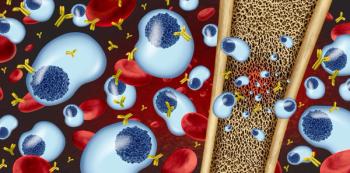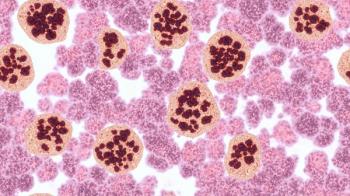
- February 2022
- Volume 88
- Issue 2
JAK Inhibitors Have Potential Uses for Treatment of Atopic Dermatitis
Pharmacists can play a critical role in this therapy, panelists in a recent Pharmacy Times® Peer Exchange say.
In a recent Pharmacy Times® Peer Exchange, experts discussed new developments in the use of Janus kinase (JAK) inhibitors for the treatment of atopic dermatitis (AD) and the critical role pharmacists can play. AD has a complex pathophysiology, according to panelist Jamie L. McConaha, PharmD, NCTTP, BCACP, CDE, an associate professor of pharmacy practice at Duquesne University School of Pharmacy in Pittsburgh, Pennsylvania.
Experts have identified 2 competing pathophysiologic principles, with the first positing an outside-in model and the second positing an immune-based model. The outside-in model suggests AD is caused by genetic epidermal barrier defects that trigger abnormal keratinocyte hyperplasia. In this model, the immune activation is considered secondary. However, the immune-based model suggests that an abnormal epidermal phenotype in lesional AD skin was infiltrated or initiated by the heightened expression of cytokines, which induces the epidermal abnormalities. “We [now] know these 2 dif- ferent models are not mutually exclusive, and we have components of both,” McConaha said.
The JAK/signal transducer and activator transcription (STAT) pathway is extremely important to the patho- physiology of AD, she said. In this pathway, ligands bind to the receptors, causing the activation of JAK, which then phosphorylates and activates the STAT pathway. In its active form, this then translocates the cell nucleus to target certain genes. Newer therapies hope to effectively treat AD by disrupting the signaling pathway and reducing inflammatory mediators.
Most patients with AD present in the first 5 years of life, according to panelist Peter Lio, MD, a clinical assistant professor of dermatology and pediatrics at Northwestern University Feinberg School of Medicine in Chicago, Illinois. He estimated that more than 80% of patients present with AD before the age of 5 years, although it can look different among patients. For example, some patients may have more acute lesions, some may have more subacute lesions, and some may present with chronic lichenified areas, Lio said. The highest incidence of AD is seen in individuals between aged 3 to 6 months, and approximately 75% of patients will have a spontaneous remission before adolescence, McConaha said.
Clinicians should consider many factors when selecting a therapy for patients with AD. Lio said he takes into account 5 aspects when selecting a therapy: accessibility, efficacy onset, maximum effect, safety, and tolerability. Considering all these issues can be especially challenging given the time constraints placed on many pharmacists and physicians, but he said ensuring communication between care team members is essential. “All these things go into play, and we want to make sure we flesh that out during the visit,” Lio said. “As a health care team, we [must] communicate with each other.”
Nonsteroidal agents include pimecrolimus and tac- rolimus, which have been around for several decades, according to panelist Kristen Demundo, PharmD, supervising pharmacist at Long Island Apothecary in Commack, New York. Crisaborole is a newer option, and it has been especially popular for the treatment of pediatric patients because it avoids common adverse effects (AEs) found in steroidal agents, she said. Common AEs with nonsteroidal agents include application site reactions, although these reactions tend to decrease with continued use, Demundo said. But cost can be a barrier, Lio said.
Systemic agents such as azathioprine, cyclospo- rine, and methotrexate are typically reserved for individuals with moderate to severe disease or patients who have not responded to some of the topical thera- pies. Although these agents have significant amounts of data available regarding their efficacy, AEs can present more significant issues because these agents are oral, McConaha said.
Meanwhile, Demundo turned to a discussion of JAK inhibitors and their potential uses. The JAK family consists of 4 components: JAK1, JAK2, JAK3, and tyrosine kinase 2. Inhibitors can target 1 or more of these components, thereby improving symptoms and signs of AD. “They work quickly to block nerve itch signals, and they also have anti-inflammatory properties,” she said.
“The JAK inhibitors work at an immune system level and are able to broadly target several symptoms of this disease,” Demundo said. “They also target different combinations of kinases, and they have var- ious mechanisms of action and safety profiles.”
Some ongoing clinical trials and upcoming potential FDA approvals with JAK inhibitors are very encouraging, said panelist Shannon M. Rotolo, PharmD, BCPS, a clinical pharmacy specialist at the University of Chicago Medicine in Illinois. Notably, however, she pointed out that some of those studies are in adolescent and adult patients, so they may have limited uses in the large proportion of pediatric patients with AD.
Involving other care team members is also important when making treatment decisions for patients with complicating factors, such as bacterial infections or gastrointestinal disorders. Providing patient education about the proper application of topical medications is also an essential role for pharmacists. For example, Rotolo pointed out that the instruction to apply a “pea-sized amount” of cream can have different meanings to patients, so educating them by describing either a thick or thin layer could be more helpful.
Instructing patients about adherence is another key role for pharmacists, especially for parents of children with AD. The average caregiver or parent spends 3 hours each day on skin care for their child, so providing education and reinforcement about the importance of therapy can help patients achieve better control of their dermatitis, Rotolo said.
“What pharmacists can provide [is] certainly monitoring for safety and for efficacy, helping families identify something that’s cost effective for them, helping our physician colleagues work through the process of prior authorizations, and things like that,” Rotolo said. “But, oftentimes...it’s also a listening ear and letting that family know they’re supported with the high adherence burden for these medications, [and the] potentially high cost burden, as it may take multiple different types of therapies to achieve control.”
Articles in this issue
almost 4 years ago
OTC Cases: February 2022almost 4 years ago
Interactive Case Studies: February 2022almost 4 years ago
Be Aware of Age-Related Mix-Ups of COVID-19 Vaccinesalmost 4 years ago
Korsuva From Cara Therapeutics and Vifor Pharmaalmost 4 years ago
OTC Product News: February 2022almost 4 years ago
Human Embryo Models Research Paves Way for Nonhormonal Contraceptionalmost 4 years ago
Minnesota Fights Back Against Rising Insulin Costsalmost 4 years ago
Pharmacist’s Role Is Key in Counseling Patientsalmost 4 years ago
Point-of-Care Drug Information Resources Are Criticalalmost 4 years ago
Generic Product News: February 2022Newsletter
Stay informed on drug updates, treatment guidelines, and pharmacy practice trends—subscribe to Pharmacy Times for weekly clinical insights.




















































































































































































































